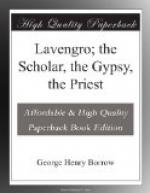Borrow was not the man to whistle and let the world go by. His advice to his country men and women was: ’To be courteous to everybody as Lavengro was, but always independent like him, and if people meddle with them, to give them as good as they bring, even as he and Isopel Berners were in the habit of doing; and it will be as well for him to observe that he by no means advises women to be too womanly, but, bearing the conduct of Isopel Berners in mind, to take their own parts, and if anybody strikes them to strike again.’
This is not the spirit which is patient under reproof. Borrow was not going to be sentenced by the gentility party. He would fulfil his dukkeripen. Lavengro having ended abruptly enough, Borrow took .up the tale where he had left it off; and though he kept his admirers on the tenter-hooks for six years, did at last in 1857 give to the world The Romany Rye, to which he added an Appendix. Ah! that Appendix! It is Borrow’s Apologia, and therefore must be read. It is interesting and amusing, and is therefore easily read. But it is a cruel and outrageous bit of writing all the same, proving, were proof needed, that it is every whit as easy to be spiteful and envious in dells as in drawing-rooms, and as vain and egotistical on a Norfolk Broad as in Grosvenor Square. In this Appendix Borrow defends ‘Lavengro,’ both the book and the man, at some length, and with enormous spirit. At gentility in all its manifestations he runs amuck. The Stuarts have a chapter to themselves. Jacobites, old and new; Papists, old and new; and, alas! Sir Walter Scott as the father of ‘Charley o’er the Waterism,’ all fall by turn under the lash of Lavengro. The attack on the memory of Sir Walter is brutal. Not so, we may be sure, did Pearce, and Cribb, and Spring, and Big Ben Brain, and Broughton, heroes of renown, win name and fame in the brave days of old. They never struck a man when he was down, or gloated over a rival’s fall. However, it will not do to get angry with George Borrow. One could never keep it up. Still, the Appendix is a pity.




